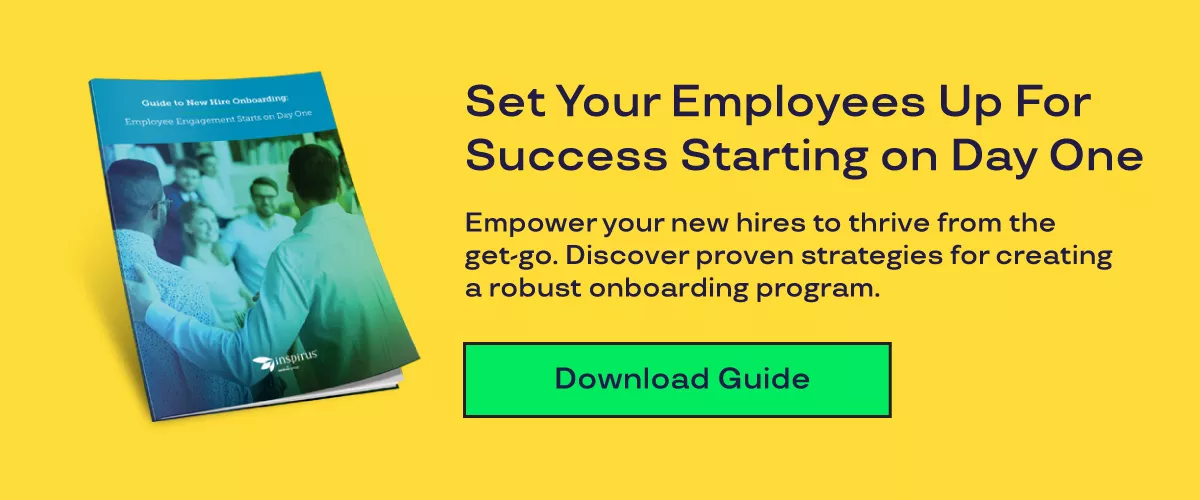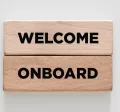
Understanding the Nuances of Onboarding Vs. Orientation
March 6, 2024
There are two ways to approach an employee’s first day on the job. You could look at it as a checklist of orientation activities.
Or it could mark the start of a long-term onboarding process. But what’s the difference between onboarding versus orientation?
While often used interchangeably, the terms ‘onboarding’ and ‘orientation’ actually mean two different things. Orientation is essentially a one-time event to welcome and situate new employees at your organization, while an onboarding program is a comprehensive process that helps align employees with company values and helps create a strong workplace culture.
Each serves a unique purpose which is why it’s so important for organizations to include both onboarding and orientation in the employee integration plan.
Read on for more about establishing a structured introduction process for new employees that includes both these foundational elements and their respective roles in fostering long-term employee engagement.
The Holistic Onboarding Process
Done thoughtfully, onboarding is so much more than just an introduction to a new job. It’s a way to ensure that new employees are integrated smoothly into their roles and the overall company culture.
The first step is to think about your overall goals. This will inform the activities, initiatives and onboarding schedule needed to set new hires up for success from the start.
A holistic onboarding process can help you achieve goals like:
- Providing new employees with the tools, resources and support they need to excel
- Clarifying roles and responsibilities
- Familiarizing all employees with the company's mission, vision and values
- Bringing new employees into the team and culture from Day One
- Offering ongoing support and professional development
- Boosting employee engagement, job satisfaction, productivity and retention
A well-executed onboarding program sets the stage for long-term success for both the individual employee and the organization as a whole.
Why Is Employee Onboarding So Important?
It goes without saying that having a concrete employee onboarding program is important. Of course, you can’t just expect someone new on the job to know everything with no support!
Filling out the necessary paperwork, getting the right logins and access, having a tour of the facilities, meeting the rest of the team – yes, those are all important. That all falls within the camp of orientation, though.
Equally important during this period is the opportunity to validate the new employee’s decision to join your organization and instill a sense of investment and ownership in your company's success. The onboarding phase serves as a pivotal moment to establish the foundation for the employee's journey. It’s also the best window of time for a new employee to get to know and integrate themselves into the great company culture that you’ve built.
The benefits are far-reaching, with onboarding touching every aspect of success:
- Smoother workflows and better communication
- Better teamwork and rapport among colleagues
- Increased transparency and accessibility of information
- A surge in accountability and ownership on the job
- A more positive work environment
- Boosted productivity and efficiency
Investing in a comprehensive onboarding process goes a long way in creating a thriving, inclusive workplace culture that uplifts each employee and ensures everyone can do their best work.
Onboarding and Orientation Best Practices and Strategies
While there is no one-size-fits-all onboarding template, there are several tried-and-true best practices that can set the stage for a successful integration process. From fostering a vibrant company culture to harnessing the power of technology, here are some key strategies to navigate the intricacies of employee onboarding.
The Initial Employee Introduction (Orientation)
Approach orientation as the first step in your onboarding process. Orientation provides new employees with a basic understanding of company policies, workplace norms and essential information. This phase is crucial for setting the foundation upon which the broader onboarding experience is built.
The duration and structure of orientation programs will vary depending on an organization's size, industry and specific needs. In some cases, orientation may be a single-day event. For others, it may span several days or even weeks.
Regardless of the duration, the primary objective of orientation is to ensure that new employees have the information and resources they need to get started on the right foot.
ORIENTATION TIP: Implement a mentorship program where new hires are paired with experienced employees who can provide guidance and support as they navigate both their roles and organizational culture. This not only helps new employees feel more connected and supported, but also facilitates knowledge sharing and skill development.
Foster Employee Engagement From Day One
Employee engagement starts Day One and it's key to lay the groundwork for a positive experience during the onboarding process.
Take a human-centered approach to onboarding by acknowledging the unique preferences and strengths of individual employees, tailoring the process to their backgrounds, skills and aspirations. This more personalized onboarding experience with customized learning paths and individualized mentorship ultimately leads to a smoother integration into the company culture.
ENGAGEMENT TIP: Encourage cross-departmental interactions during this critical onboarding time by bringing together employees with different roles and functions. Actively promoting a sense of community and interconnectedness helps foster a collaborative spirit and a broader understanding of the organization.
Leverage Employee Onboarding Technology
Technology is a game-changer in successful employee onboarding. By leveraging the right tools and platforms, organizations streamline and enhance the onboarding experience, making it more efficient, effective and engaging for new hires.
For instance, technology can be used to automate certain aspects of the onboarding process, such as sending out welcome emails or scheduling training sessions. Online onboarding portals, as another, provide a centralized location for new hires to access all the information and resources they need to get started, including company policies, training materials and contact information for key personnel.
An important note about onboarding technology: Don’t think about it exclusively in terms of orientation activities.
An employee engagement platform brings teams together whether they’re remote, hybrid or in-person to create meaningful connections from the start. This can help with the mentorship aspect of onboarding, while also building a culture of recognition and appreciation. Fostering a sense of community and a positive work environment isn’t something that happens suddenly, months after a new hire has joined. The roots are laid from the very first day.
ONBOARDING TECHNOLOGY TIP: Gather feedback from new hires about their onboarding experience. This can be done through online surveys or feedback forms, allowing organizations to identify areas for improvement and make adjustments as needed.
The Synergy Between Onboarding and Orientation
When used together, onboarding and orientation enhance the employee integration process, leading to better employee engagement. Orientation provides new hires with the necessary information and resources to get started, while onboarding ensures that they feel supported and valued throughout their journey.
By combining the two, organizations can create a seamless and comprehensive onboarding experience that sets new hires up for success each and every day.
Frequently Asked Questions
What are the 5 C's of employee onboarding?
The 5 C's of employee onboarding are: compliance, clarification, culture, connection and confidence. Combined, these elements ensure new hires feel confident in their abilities and connected to the organization.
How do you keep employees engaged during onboarding?
Provide interactive training, assign a mentor, encourage questions and involve new hires in team activities to foster a sense of belonging and connection from the start.
What are the 4 phases of employee onboarding?
Employee onboarding can be broken down into four main phases: pre-boarding (before the first day), orientation (first day or week), initial training (first few weeks) and ongoing support throughout the entire journey.
What is an onboarding checklist?
An onboarding checklist outlines the tasks and activities new hires need to complete during the onboarding process, ensuring they have everything needed to succeed. It can also be used to track onboarding goals from HR’s perspective to ensure the process is successfully engaging and supporting employees.





